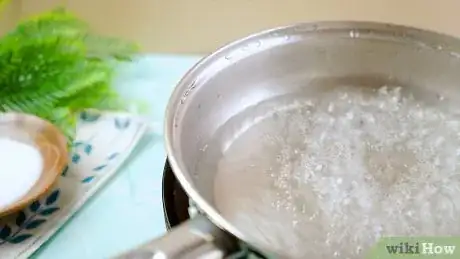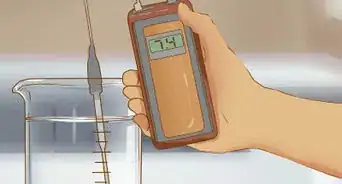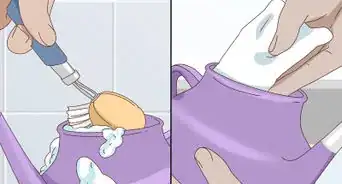This article was medically reviewed by Luba Lee, FNP-BC, MS and by wikiHow staff writer, Dan Hickey. Luba Lee, FNP-BC is a Board-Certified Family Nurse Practitioner (FNP) and educator in Tennessee with over a decade of clinical experience. Luba has certifications in Pediatric Advanced Life Support (PALS), Emergency Medicine, Advanced Cardiac Life Support (ACLS), Team Building, and Critical Care Nursing. She received her Master of Science in Nursing (MSN) from the University of Tennessee in 2006.
There are 10 references cited in this article, which can be found at the bottom of the page.
wikiHow marks an article as reader-approved once it receives enough positive feedback. In this case, 100% of readers who voted found the article helpful, earning it our reader-approved status.
This article has been viewed 1,270,943 times.
Saline solution is handy for tasks like cleaning piercings or irrigating your sinuses, but it can get inconvenient to go out and buy more every time you run out. How can you make an effective solution at home? “Normal” saline is about 0.9% salt and is a breeze to make yourself—all you need is boiled or distilled water and non-iodized salt.[1] We’ve put together a step-by-step guide to making a 0.9% solution, including slight variations in the recipe to target your sinuses, piercings, or mouth. Read on to get started!
Things You Should Know
- Boil your saline container and mixing utensil for 10 minutes or run them through a full dishwasher cycle to sterilize them.
- Mix 2 teaspoons (8.4 g) of non-iodized salt in 4 cups (0.95 L) of distilled or boiled water. Wait until the solution is room temperature to use.
- Use homemade saline to clean wounds and piercings, irrigate your sinuses, rinse your mouth, or clean out your ears.
Steps
Making Saline at Home
-
1Boil 4 cups (0.95 L) of tap water in a sterilized pot for 5 minutes. Add water to the pot directly from the tap or with a sterilized measuring cup. Once boiling, let the water roll and bubble for at least 5 minutes to eliminate bacteria. Turn off the heat and let the water cool to lukewarm.[2]
- Alternatively, use or purchase distilled water to skip the boiling process.
- If you’re in a hurry, microwave the water in a covered container for 2 minutes until it’s boiling or almost boiling.
- Plan to use the water quickly after boiling. If it sits too long, it will collect bacteria again.[3]
- Avoid using well water or sea water, since these contain more particles and germs than you get from your tap.
-
2Stir in 2 teaspoons (8.4 g) of non-iodized salt until it’s dissolved. Regular table salt grains are small enough to dissolve easily in hot water. If you’re using sea salt, opt for small grains or flakes rather than large crystals. Stir while the water is still lukewarm to help the salt dissolve.[4]
- If you’re making saline for oral swishing, add 4 teaspoons (16.7 g) of salt and 8 teaspoons (33.5 g) of baking soda (the baking soda makes the solution less abrasive).[5]
- For nasal irrigation, add 3 teaspoons (12.6 g) of salt and 1 teaspoon (4.2 g) of baking soda.[6]
- To clean piercings, add 1 teaspoon (4.2 g) of salt (super salty saline may irritate the piercing more than it helps).[7]
Advertisement -
3Wait until the solution is room temperature to use it. This keeps you from burning or irritating your skin, wounds, or orifices.[8] To transfer the saline to a syringe or irrigating tool, pour it directly from the pot into a clean paper cup, then dip your syringe into the cup.[9]
- Avoid dipping non-sterilized tools or utensils directly into the solution.
-
4Store extra saline in an airtight container for 3 days at room temperature. Pour leftover solution into a tightly covered glass or plastic container and label it with the date.[10] After 3 days, dump any remaining solution, re-sterilize the container, and make a new batch if needed.[11]
Using Homemade Saline
-
1Clean wounds with a gauze pad dipped in saline. Put on disposable gloves and place a towel underneath the wound. Dab the wound in a circular motion, working outward from the center to prevent germs spreading inward. Use multiple pads if needed to remove all debris and draining liquids.[12]
- Pat the wound with a clean, dry cloth to dry it.
- Throw away your gloves and saline-soaked gauze after cleaning.
- Apply a new dressing to the wound if necessary.
-
2Irrigate your sinuses with a neti pot or soft rubber ear bulb syringe. Draw 8 fluid ounces (240 mL) of saline into the bulb or syringe. Lower your head over a sink (or in the shower) and rotate to the left so your right nostril is raised. Squeeze half the solution into your right nostril and wait a few seconds for it to come out of your left.[13]
- Repeat this process through the other nostril.
- Breathe through your mouth while the saline runs from one nostril to the other.
- Blow your nose gently to keep the saline from running into your ears. If it does, it’s OK—the mild discomfort will go away after a few minutes.
- Irrigate at least 30 minutes before applying any other nasal medication.
-
3Clear out earwax with a cotton ball dipped in saline. Tilt your head to one side and drip saline into your ear from the soaked cotton ball. Let the solution sit for a few minutes, then tilt your head the opposite way to drain it out. Repeat in the other ear.[14]
- Alternatively, add saline to your ears with a small syringe.[15]
-
4Swish saline in your mouth for 30 seconds to relieve oral pain. Simply rinse a mouthful of solution around your teeth and gums 2-3 times per day, then spit it out. The saline acts as an antiseptic to kill bacteria and speeds up healing for oral wounds and sores.[16]
- Also try gargling saline to soothe a sore throat.
- Homemade saline is non-toxic if you accidentally swallow it.
-
5Soak piercings for 5-10 minutes daily to clean and disinfect them. Pour saline into a small cup or shot glass and invert it over your piercing to form a vacuum. If the location makes this too difficult, use a cotton pad or paper towel that’s dipped in saline to clean the piercing site or add your saline to a spray bottle.[17]
- Dry the piercing gently with clean paper towels.
- Avoid using cloth towels since they contain more bacteria (and are more likely to give you an infection).
Expert Q&A
Did you know you can get premium answers for this article?
Unlock premium answers by supporting wikiHow
-
QuestionCan I use saline on my face as a beauty product?
 Luba Lee, FNP-BC, MSLuba Lee, FNP-BC is a Board-Certified Family Nurse Practitioner (FNP) and educator in Tennessee with over a decade of clinical experience. Luba has certifications in Pediatric Advanced Life Support (PALS), Emergency Medicine, Advanced Cardiac Life Support (ACLS), Team Building, and Critical Care Nursing. She received her Master of Science in Nursing (MSN) from the University of Tennessee in 2006.
Luba Lee, FNP-BC, MSLuba Lee, FNP-BC is a Board-Certified Family Nurse Practitioner (FNP) and educator in Tennessee with over a decade of clinical experience. Luba has certifications in Pediatric Advanced Life Support (PALS), Emergency Medicine, Advanced Cardiac Life Support (ACLS), Team Building, and Critical Care Nursing. She received her Master of Science in Nursing (MSN) from the University of Tennessee in 2006.
Board-Certified Family Nurse Practitioner
Warnings
Things You’ll Need
- Large pot
- Airtight glass or plastic container
- Mixing utensil
- Non-iodized table salt or fine sea salt
- Distilled or boiled water
- Baking soda (optional)
References
- ↑ https://intermountainhealthcare.org/ckr-ext/Dcmnt?ncid=520684503
- ↑ https://intermountainhealthcare.org/ckr-ext/Dcmnt?ncid=520684503
- ↑ https://www.phoenixchildrens.org/files/inline-files/How-To-Make-Sterile-Water-and-Sterile-Saline-861.pdf
- ↑ https://www.phoenixchildrens.org/files/inline-files/How-To-Make-Sterile-Water-and-Sterile-Saline-861.pdf
- ↑ https://www.ianbelldds.com/p/BLOG-26443-2016.2.17-Make-Your-Own-Oral-Saline-Solution-p.asp
- ↑ https://www.aaaai.org/tools-for-the-public/conditions-library/allergies/saline-sinus-rinse-recipe
- ↑ https://authoritytattoo.com/saline-solution-for-piercings/
- ↑ https://intermountainhealthcare.org/ckr-ext/Dcmnt?ncid=520684503
- ↑ https://www.phoenixchildrens.org/files/inline-files/How-To-Make-Sterile-Water-and-Sterile-Saline-861.pdf
- ↑ https://intermountainhealthcare.org/ckr-ext/Dcmnt?ncid=520684503
- ↑ https://www.phoenixchildrens.org/files/inline-files/How-To-Make-Sterile-Water-and-Sterile-Saline-861.pdf
- ↑ https://intermountainhealthcare.org/ckr-ext/Dcmnt?ncid=520684503
- ↑ https://blogs.bcm.edu/2014/08/20/saline-irrigation-offers-natural-option-for-sinus-infection-allergy-relief/
- ↑ https://totalhearingcarellc.com/blog/4-tips-to-clean-your-ears
- ↑ https://my.clevelandclinic.org/health/diseases/14428-ear-wax-buildup--blockage
- ↑ https://www.ianbelldds.com/p/BLOG-26443-2016.2.17-Make-Your-Own-Oral-Saline-Solution-p.asp
- ↑ https://authoritytattoo.com/saline-solution-for-piercings/
- ↑ https://www.phoenixchildrens.org/files/inline-files/How-To-Make-Sterile-Water-and-Sterile-Saline-861.pdf
- ↑ https://www.phoenixchildrens.org/files/inline-files/How-To-Make-Sterile-Water-and-Sterile-Saline-861.pdf
- ↑ https://www.aaaai.org/tools-for-the-public/conditions-library/allergies/saline-sinus-rinse-recipe
- ↑ https://www.aao.org/eye-health/diseases/contact-lens-related-eye-infections
- ↑ https://www.drugs.com/cg/how-to-use-a-nebulizer.html
About This Article
To make a saline solution, start by bringing 1 cup of water and ½ teaspoon of regular table salt or sea salt to a boil on the stove. Make sure you use salt that doesn’t contain iodine or preservatives, which can irritate your skin and nasal lining. Next, let the solution boil for 15 minutes, then allow it to cool before using it. Alternatively, store the solution in a sterile jar or bottle so that it stays effective until you're ready to use it. For tips on how to make your saline solution weaker for a child or stronger for an adult, keep reading!































































Medical Disclaimer
The content of this article is not intended to be a substitute for professional medical advice, examination, diagnosis, or treatment. You should always contact your doctor or other qualified healthcare professional before starting, changing, or stopping any kind of health treatment.
Read More...